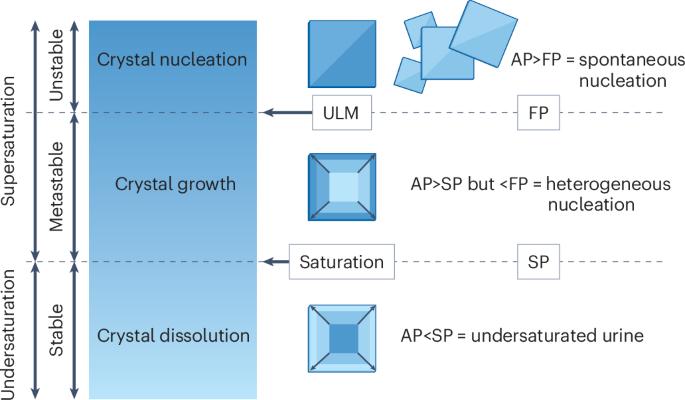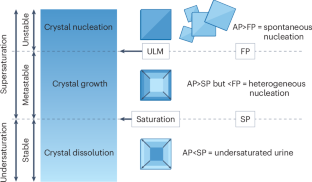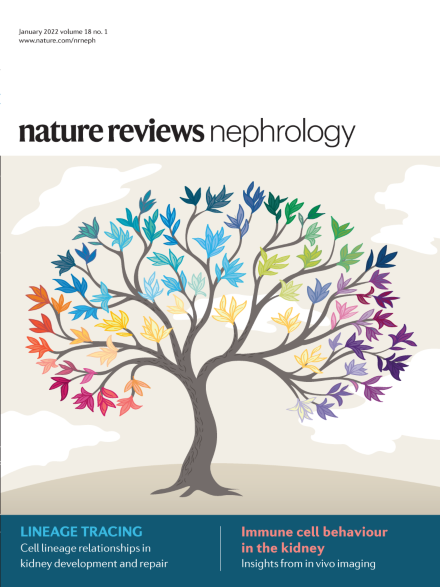肾结石疾病:危险因素、病理生理和管理
IF 39.8
1区 医学
Q1 UROLOGY & NEPHROLOGY
引用次数: 0
摘要
肾结石是影响肾脏和泌尿道的最常见健康状况,构成了一个主要的全球卫生保健问题。在过去的50年里,肾结石的患病率大大增加,无论年龄、性别或种族。肾结石发病率高,生活质量下降,医疗保健支出巨大,这主要是由于肾结石经常复发。此外,肾结石现在被认为是一种全身性疾病,与慢性肾病、心血管疾病、代谢综合征和低骨量的风险增加有关。肾结石表现出明显的病理生理异质性。饮食和环境暴露与遗传易感性相互作用,形成个体疾病风险。草酸钙结石最为常见,通常由高钙尿、高草酸尿、低尿和低尿量引起,而尿酸和磷酸钙结石的形成通常与尿ph有关。全面的临床评估可以发现潜在的代谢异常,区分特发性、继发性和孟德尔式肾结石,识别全身性疾病关联并指导治疗。复发预防需要个体化策略,结合饮食和药物干预。对于已形成的结石,手术治疗是有效的,输尿管镜检查和经皮肾镜取石术可获得较高的结石清除率。尽管肾结石有相当大的临床和社会负担,但肾结石仍未得到充分认识、服务和研究。迫切需要提高对研究、创新和教育的认识和投资。本文章由计算机程序翻译,如有差异,请以英文原文为准。


Kidney stone disease: risk factors, pathophysiology and management
Nephrolithiasis is the most common health condition affecting the kidney and urinary tract and constitutes a major global health-care problem. The prevalence of nephrolithiasis has increased substantially over the past five decades, irrespective of age, sex or ethnicity. Kidney stones cause substantial morbidity, reduced quality of life and enormous health-care expenditure, largely due to their frequent recurrence. Furthermore, nephrolithiasis is now recognized as a systemic condition associated with increased risks of chronic kidney disease, cardiovascular disease, metabolic syndrome and low bone mass. Nephrolithiasis exhibits marked pathophysiological heterogeneity. Dietary and environmental exposures interact with genetic predisposition to shape individual disease risk. Calcium oxalate stones are most prevalent, commonly driven by hypercalciuria, hyperoxaluria, hypocitraturia and low urine volume, whereas the formation of uric acid and calcium phosphate stones is commonly linked to urinary pH. A comprehensive clinical evaluation can uncover underlying metabolic abnormalities, distinguish idiopathic, secondary and Mendelian forms of nephrolithiasis, identify systemic disease associations and guide therapy. Recurrence prevention requires individualized strategies that combine dietary and pharmacological interventions. For established stones, surgical management is effective, with ureteroscopy and percutaneous nephrolithotomy achieving high stone-free rates. Despite its considerable clinical and societal burden, nephrolithiasis remains under-recognized, underserved and under-researched. Greater awareness and investments in research, innovation and education are urgently needed. This Review discusses the pathophysiology of kidney stone formation and examines the contribution of urinary risk factors and genetic variants. The authors also consider current approaches to the management of nephrolithiasis, including the role of metabolic evaluation and interventions for prevention of kidney stone recurrence.
求助全文
通过发布文献求助,成功后即可免费获取论文全文。
去求助
来源期刊

Nature Reviews Nephrology
医学-泌尿学与肾脏学
CiteScore
39.00
自引率
1.20%
发文量
127
审稿时长
6-12 weeks
期刊介绍:
Nature Reviews Nephrology aims to be the premier source of reviews and commentaries for the scientific communities it serves.
It strives to publish authoritative, accessible articles.
Articles are enhanced with clearly understandable figures, tables, and other display items.
Nature Reviews Nephrology publishes Research Highlights, News & Views, Comments, Reviews, Perspectives, and Consensus Statements.
The content is relevant to nephrologists and basic science researchers.
The broad scope of the journal ensures that the work reaches the widest possible audience.
 求助内容:
求助内容: 应助结果提醒方式:
应助结果提醒方式:


